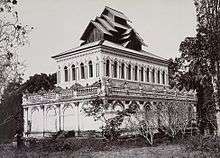Ordination hall
The ordination hall (Burmese: သိမ်; Lao: ສິມ; Thai: อุโบสถ or โบสถ) is a Buddhist building specifically consecrated and designated for the performance of the Buddhist ordination ritual (upasampada) and other ritual ceremonies, such as the recitation of the Patimokkha.[1][2] The ordination hall is located within a boundary (sīmā) that defines "the space within which all members of a single local community have to assemble as a complete Sangha (samagga sangha) at a place appointed for ecclesiastical acts (kamma)." [3] The constitution of the sīmā is regulated and defined by the Vinaya and its commentaries and sub-commentaries.[3]
Burmese ordination halls
In Burmese, ordination halls are called thein (သိမ်), derived from the Pali term sīmā, which means"boundary." The thein is a common feature of Burmese monasteries (kyaung), although the thein may be not necessarily be located on the monastery compound.[2] Shan ordination halls, called sim (သိမ်ႇ), are exclusively used for events limited to the monkhood.[4][5]
Thai ordination halls
In Thai, ordination halls are called ubosot or bot, derived from the Pali term uposathagara. The bot is the focal point of Central Thai temples, whereas the focal point of Northern Thai temples is the stupa.[4] The bot, as the wat's principal building, is also used for communal services.[2][4] In the Thai tradition, the boundary of the ordination hall is marked by bai sema, a series of eight boundary stones marking the sīmā. The oldest bai sema date to the Dvaravati period.[3]
See also
References
- ↑ Murphy, Stephen A. (2014). "Sema Stones in Lower Myanmar and Northeast Thailand: A Comparison". Before Siam: Essays in Art and Archaeology. River Books & The Siam Society.
- 1 2 3 O'Connor, Richard A. (2009). "Place, Power and People: Southeast Asia's Temple Tradition". Arts asiatiques. 64 (1): 116–123. doi:10.3406/arasi.2009.1692.
- 1 2 3 Kieffer-Pülz, Petra (1997). "Rules for the sīmā Regulation in the Vinaya and its Commentaries and their Application in Thailand". Journal of the International Association of Buddhist Studies. 20 (2): 141–153. ISSN 0193-600X.
- 1 2 3 Tannenbaum, Nicola (1990). "THE HEART OF THE VILLAGE: CONSTITUENT STRUCTURES OF SHAN COMMUNITIES". Crossroads: An Interdisciplinary Journal of Southeast Asian Studies. 5 (1): 23–41.
- ↑ Sao Tern Moeng (1995). "Shan-English Dictionary". Dunwoody Press.
